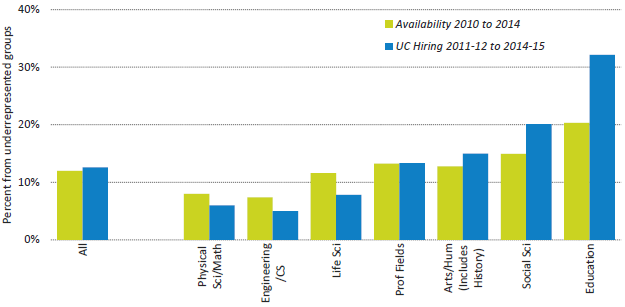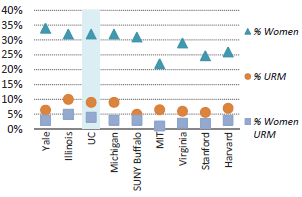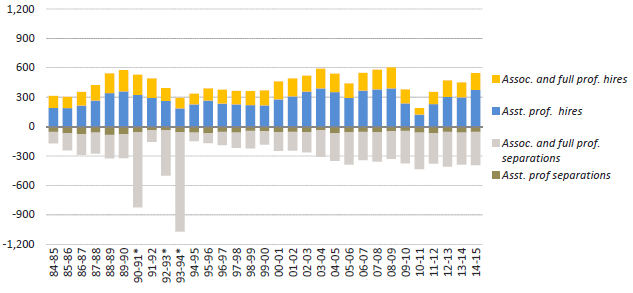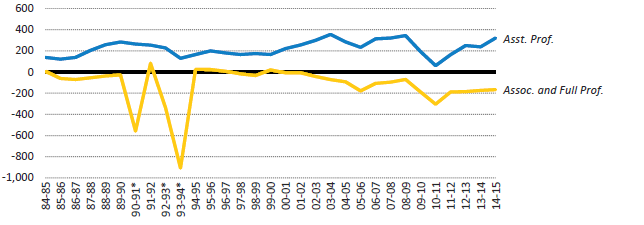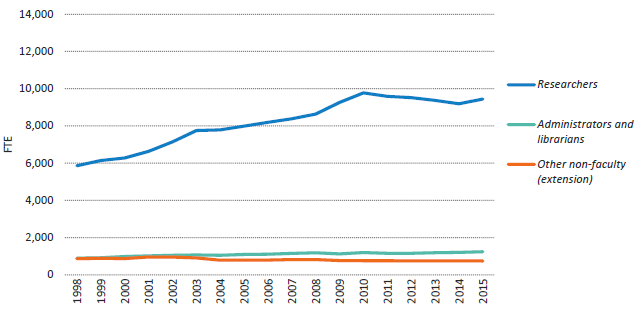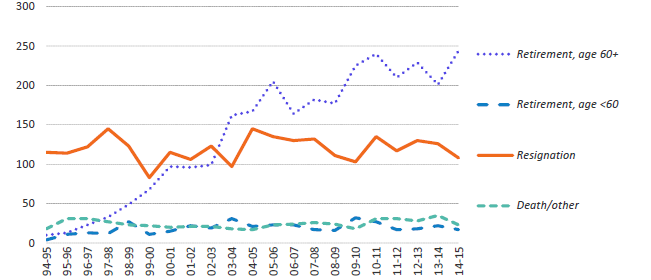The quality and stature of the University of California are due to its distinguished faculty. President Napolitano has said, “We teach for California … [and] we research for the world.” UC faculty serve as a rich source of innovation, discovery and mentorship; they provide top-quality education to students, and groundbreaking research and service to California communities as well as national and international disciplinary societies. No other public institution can claim as distinguished a group of individuals: UC faculty have won 62 Nobel prizes and 67 National Medals of Science. As of 2015, UC academics included over 580 members of the National Academy of Sciences and over 500 members of the American Academy of Arts and Sciences.
Describing the academic workforce
Faculty are dedicated to a range of teaching, research and creative work, to clinical service and to public service functions in a vast array of disciplinary areas, including the health sciences. The descriptive data in this chapter provide an outline of the composition of the UC faculty that only hints at the full scope of faculty specialties and expertise.
The faculty renewal pipeline
Over the last few years, new hires have increased as UC recovers from the severe budget cuts of prior years. Faculty diversity has increased and departure rates have declined.
Competitiveness of faculty salaries — Faculty salaries at UC still trail those at comparison institutions by about 10 percent. UC compares its faculty salaries to the average of salaries at the “Comparison 8,” a comparator group composed of four public and four private institutions. UC and the state set a goal for UC salaries to be at the midpoint between these two averages, but UC salaries have lagged behind this benchmark for the last 14 years. According to the 2014 update of UC’s Total Remuneration Study for General Campus Ladder-Rank Faculty, UC’s 6 percent above-market positioning for retirement is offset by 7 percent below-market positioning for health and welfare benefits. When combined with UC’s below-market cash compensation, this leads to total remuneration 10 percent below market in comparison to UC’s peers.
Diversity — The University of California is committed to diversifying its faculty, taking full advantage of the availability of qualified candidates. The Office of the President is working with campuses by tracking faculty recruitment data to identify opportunities to diversify the faculty; by sharing best practices in faculty mentoring and professional development; and by enhancing programs to foster work-life balance. The proportion of women and underrepresented racial/ethnic groups (URMs) in the faculty continues to grow at a modest pace. When these diversity figures are displayed in the context of eight peer research institutions that make up UC’s standard comparator group, UC compares favorably. According to 2014 data, UC is tied for second place, at 32 percent, for the percentage of female faculty. UC also places second for the percentage of URM faculty and female URM faculty. However, there is still work to be done. Data comparing U.S. doctoral degree recipients and UC’s new faculty hires show that in many disciplines, the share of faculty from underrepresented groups among new UC assistant professors remains below the share in the national pool of available candidates.
Diversity initiatives
A wide variety of diversity programs are in place throughout the UC system to build a more diverse faculty. Notable among these programs are the President’s Postdoctoral Fellowship Program Special Presidential Initiative, the Leadership Seminar Series for Deans and Chairs, and campus-based ADVANCE programs.
President’s Postdoctoral Fellowship Program Special Presidential Initiative — Established in 1984, the President’s Postdoctoral Fellowship Program (PPFP) recruits top scholars with proven commitments to underserved and minority communities to pursue faculty careers at UC. As part of a special initiative to enhance the work of PPFP, the president has committed additional one-time funds to the program, with $2.4M targeted to support startup costs for fellows hired into STEM faculty positions, including the health sciences. The president also committed $2.1M as additional support for the hiring incentive offered to departments that hire fellows into the faculty. She also committed $475K to training seminars for chairs and deans in which they studied best practices in creating welcoming department climates. The National Institutes of Health (NIH) is using PPFP as a model for postdoctoral recruiting, and PPFP was featured at a recent panel presentation during the National Postdoctoral Association convention.
Grant-funded research — In 2015, UC was awarded a National Science Foundation (NSF) grant to study the faculty hiring process over a three-year period. The study will identify the steps in UC’s hiring process that are most susceptible to bias and the characteristics of the hiring process that amplify or mitigate disparities, and will identify the most important targets for policies designed to promote equity, inclusion, and diversity among faculty. UC was also awarded a five-year grant to establish the Center for Research, Excellence and Diversity in Team Science (CREDITS), an integrated research and training program aimed at increasing and enhancing the capacity, effectiveness and excellence of team science efforts at both UC and CSU. CREDITS will also conduct research about gender and racial/ethnic diversity in team science. In particular, the PI group is looking to answer questions about barriers to diverse participation on science teams, how diversity shapes the formation of science teams and how diversity and team science are implicated in promotion and tenure practices and policies at a variety of institutional types. A third program, MAGIC, is affiliated with the National Research Mentoring Network (NRMN) (https://nrmnet.net), and is a program through which UC will develop a “train the trainer” event on mentoring a diverse population in the biomedical fields at all levels in higher education: undergraduate, graduate, postdoc and faculty. The event will be modelled after the UC ADVANCE PAID Roundtables.
Faculty Exit Survey — In an effort to better understand and improve the experience of faculty members at UC, UC has partnered with Harvard's Collaborative on Academic Careers in Higher Education (COACHE) on a research project to survey faculty who leave UC for employment at other universities. The survey will collect information on URM and non-URM faculty who leave UC.
ADVANCE Programs across UC — Throughout the United States, the National Science Foundation (NSF) has sponsored the ADVANCE Programs with the goal of developing “systematic approaches to increase the representation and advancement of women in academic science and engineering careers, thereby contributing to the development of a more diverse science and engineering workforce.” There have been active ADVANCE programs at UC Office of the President, UC Berkeley, UC Davis, UC Irvine, UC Merced, UC Riverside, UC San Diego, UC Santa Barbara and Hastings College of Law.
To incentivize the hiring of STEM-focused faculty members who have demonstrated a deep commitment to doing outreach, mentoring or research in engagement with underserved communities, UC Davis established the Center for Multicultural Perspectives on Science (CAMPOS) in 2013, and the provost has provided incentive funding comparable to that for the President’s Postdoctoral Fellowship Program. The CAMPOS Scholars are new ladder-rank faculty who are selected for the program based on their transformative thinking, unique perspectives, interdisciplinary approaches and leadership potential to affect their STEM discipline in profound and enduring ways. The program has hired 13 faculty as CAMPOS Scholars, and three additional Scholars are being actively recruited.
Faculty emeriti
Even in retirement, UC faculty remain active in academia and are frequently recognized for their continued contributions. The Council of University of California Emeriti Associations (CUCEA) recently conducted a survey of over 1,600 UC emeriti to inventory the work and achievements of the University’s retired faculty. The survey shows that during the period of 2012 to 2015, this group of UC retirees taught more than 2,000 classes, wrote more than 500 books and over 3,000 articles, and were involved in hundreds of campus and community service efforts. In fact, 77 percent of faculty who retired in the last five years reported having research or publication work in the pipeline. This shows that in early retirement, many faculty still work with graduate students who are finishing their research, run labs with ongoing projects or have grants with time remaining.
For more information


